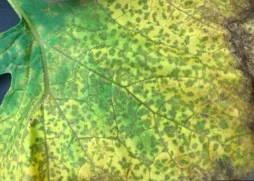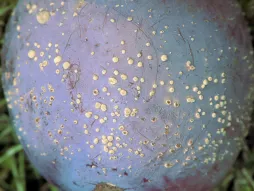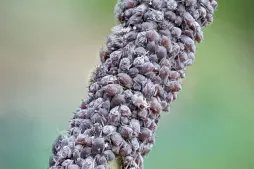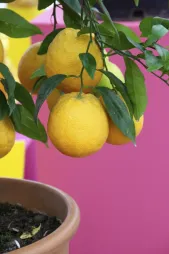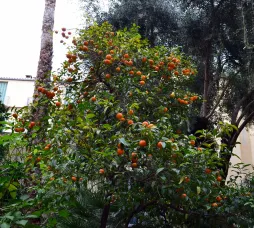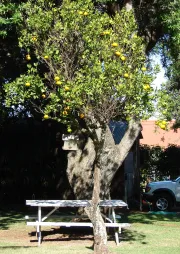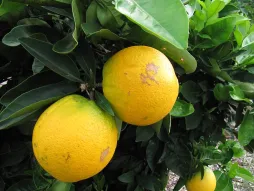Citrus hystrix, an original citrus fruit with a zest for life
When European sailors landed on the Indonesian island of Sumbawa, they discovered a curious citrus fruit. More at ease with a compass than with foreign languages, they distorted the name of the place and christened it Combava. Botanists, more literate and pragmatic, renamed this shrub from the Rutaceae family Citrus hystrix. Why did they do this? Because in Latin, hystrix means thorny.
How to recognize combava, Citrus hystrix?
Citrus hystrix is a bushy shrubthat can grow up to six meters high and three meters wide.
Like other citrus fruits, combava has a short trunk. It supports slender branches adorned with thorns. These protect the foliage from herbivorous predators.
The bright-green, oval leaves are eight to ten centimetres long. They have an outgrowth, a winged stalk, at least as long! But that's not their only distinctive feature. They also exude a sweet, suave scent.
The fragrance of the flowers is even more pronounced. White to pink,they have only four or five petals, but bear some twenty yellow stamens. Highly melliferous, they attract insects and pollinating birds.
The fruit, also known as combava, is a sphere four to six centimetres in diameter with a thick, bumpy skin. The dark-green rind turns yellow as the citrus ripens.
The shrub, like citrus × floridana and other citrus fruits, is non-toxic and is not cultivated solely for its original appearance. Its fruit is eaten in Asia, Réunion and Madagascar. Some even add Citrus hystrix leaves to their dishes. Their pungent, spicy aroma is said to be close to that of lemongrass.
Our maintenance tips
Citrus hystrix is one of the few citrus fruits that can be grown indoors. In summer, however, it can be enjoyed on a terrace or balcony to soak up the sun.
Watering
Citrus hystrix likes humidity, but not at root level. Water only when the rootball has dried to a depth of two or three centimeters.
Use non-calcareous water, such as rainwater, at room temperature. If you've placed your houseplant on a dish, empty the stagnant water each time it appears.
Spray
The Citrus hystrix love humidity. Spray their foliage to increase humidity and combat pest invasion.
Repotting
In spring, transfer your Citrus hystrix to a larger pot, so that it can continue to grow.
When roots protrude from the pot or are visible on the surface, it's time to repot!
To prepare your Citrus hystrix for repotting, soak the root ball. Then gently loosen the root ball.
Choose a terracotta pot or a wooden tub. Both materials encourage water evaporation and reduce the risk of over-watering. Make sure the container is perforated to allow water to drain away.
At the bottom, place a bed of clay balls or gravel to facilitate drainage.
Top up with a rich substrate, such as special citrus or planting soil. You can make your own mixture with :
- one-third planting soil
- one-third garden soil
- pozzolan.
Place your shrub in the center. The surface of the rootball should be two centimetres below the rim of the pot. Fill with substrate and tamp to eliminate air bubbles. When planting, do not bury the collar.
Fertilization
You can stimulate the development of your plant during its growth phase, in spring and summer, with fertilizer.
The Citrus hystrix are greedy plants. They need to be fertilized. Feed yours with a special liquid or granulated citrus fertilizer.
Cleaning
The dust that accumulates on the leaves of your Citrus hystrix slows down the photosynthesis process. To enable it to thrive, dust regularly and gently.
To remove dust, wipe both sides of the leaf with a soft, slightly damp cloth. Support the larger ones with your other hand to prevent damage.
If your plant looks dirty, you can add some black soap to the water to moisten your cloth.
To remove dust, wipe both sides of the leaf with a soft, slightly damp cloth. Support the larger ones with your other hand to prevent damage.
If your plant looks dirty, you can add some black soap to the water to moisten your cloth.
Prune
Size is not essential. It only helps to control shape and development and improves fruiting. When pruning, always use clean, sharp pruning shears.
Citrus trees flower and fruit on the year's wood. To maintain the compact, rounded shape of your shrub, remove dead branches and shoots growing along the trunk. You can also aerate the center by removing some shoots that have already borne fruit in previous years.
If you want to improve your harvest, you can also carry out a fruiting pruning operation: one month after the appearance of a new shoot, prune it back to a height of 20 centimetres.
Pinch
Pinch your Citrus hystrix during its growing season.
To encourage stem branching, pinch off the terminal buds.
Plantation
Once the last spring frosts have passed, you can plant.
Find them a place sheltered from the wind and isolated from other plants. Citrus plants have shallow roots and don't like to share their space.
Dig a hole 70 centimetres wide and 1 metre in diameter. While you're at it, soak the root ball.
Plant the plant in the middle, with the top of the rootball level with the ground. Take care not to bury the collar.
The Citrus hystrix plants thrive in light, well-drained, rich soil. When filling in, add potting soil or citrus soil to your garden soil. Tamp and water.
Diseases / Threats
Information
| Family | Rutaceae - Rutaceae |
| Type | Citrus - Citrus |
| Species | Combava - Citrus hystrix |
| Lifecycle | Perennial |
| Foliage | Evergreen |
| Exposure | |
| Substrat | |
| Planting methods |
Open ground In pots In tubs |
| Categories | |
| Tags |
Edible fruit Flowery |
| Origin |
Southeast Asia |
| Hardiness (USDA) | 9b |
| Leaf color |
|
| Flower colors |
|
| Fruit colors |
|
Discover plants from the same family















